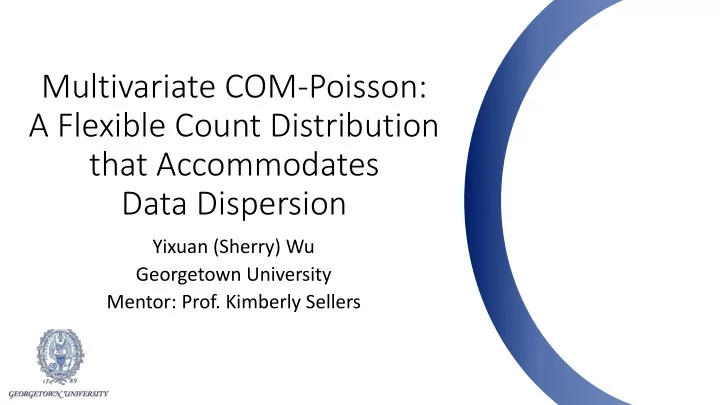

Multivariate COM-Poisson: A Flexible Count Distribution that Accommodates Data Dispersion Yixuan (Sherry) Wu Georgetown University Mentor: Prof. Kimberly Sellers
COM-Poisson Multivariate (CMP): Discussion CMP Introduction Background Analysis R Shiny
Background & Motivation Available Count Models: • Poisson Distribution • PMF for random variable Y: P ( Y = y ) = 𝜇 𝑧 𝑓 −𝜇 , 𝑧 = 0, 1, 2, ⋯ 𝑧! • Assumption: y • λ = mean = variance → equi-dispersion https://en.wikipedia.org/wiki/Poisson_d istribution#/media/File:Poisson_pmf.svg • Multivariate analog of this distribution exists Background Analysis R Shiny
Background & Motivation Available Count Models: • Negative Binomial Distribution • Accounts for over-dispersion, but not under-dispersion • Generalized Poisson Distribution • Not good when huge amount of under-dispersion Background Analysis R Shiny
Background & Motivation Available Count Models: • Negative Binomial Distribution • Accounts for over-dispersion, but not under-dispersion • Generalized Poisson Distribution • Not good when huge amount of under-dispersion Challenges: 1. Accounting for under-dispersion 2. Uncertain Dispersion Background Analysis R Shiny
COM-Poisson Distribution (Conway & Maxwell, 1962; Shmueli et al., 2005) COM-Poisson distribution PMF for random variable Y: 𝜇 𝑧 𝑄 𝑍 = 𝑧 = 𝑧! 𝜉 𝑎(𝜇,𝜉) , 𝑧 = 0, 1, 2, ⋯ ∞ 𝜇 𝑘 (𝑘!) 𝜉 ; 𝜉 ≥ 0; 𝜇 = 𝐹(𝑍 𝜉 ) where 𝑎 𝜇, 𝜉 = 𝑘=0 Captures both over-dispersion and under-dispersion Background Analysis R Shiny
COM-Poisson Distribution (Conway & Maxwell, 1962; Shmueli et al., 2005) COM-Poisson distribution PMF for random variable Y: 𝜇 𝑧 𝑄 𝑍 = 𝑧 = 𝑧! 𝜉 𝑎(𝜇,𝜉) , 𝑧 = 0, 1, 2, ⋯ ∞ 𝜇 𝑘 (𝑘!) 𝜉 ; 𝜉 ≥ 0; 𝜇 = 𝐹(𝑍 𝜉 ) where 𝑎 𝜇, 𝜉 = 𝑘=0 Special Cases: 𝜇 𝑧 𝑓 −𝜇 ➔ 𝑎 𝜇, 𝜉 = 𝑓 𝜇 ➔ 𝜉 = 1 𝑄 𝑍 = 𝑧 = ∼ 𝑄𝑝𝑗𝑡𝑡𝑝𝑜 𝜇 𝑧! 1 𝑄 𝑍 = 𝑧 = 𝜇 𝑧 (1 − 𝜇) ∼ 𝐻𝑓𝑝𝑛𝑓𝑢𝑠𝑗𝑑 (𝑞 = 1 − 𝜇) 𝜉 = 0, 𝜇 < 1 ➔ 𝑎 𝜇, 𝜉 = ➔ 1−𝜇 𝜇 𝜇 ➔ 𝑎 𝜇, 𝜉 = 1 + 𝜇 ➔ 𝜉 → ∞ 𝑄 𝑍 = 𝑧 = 1+𝜇 ∼ 𝐶𝑓𝑠𝑜𝑝𝑣𝑚𝑚𝑗 (𝑞 = 1+𝜇 ) Background Analysis R Shiny
COM-Poisson Distribution Properties Probability Generating Function (PGF): 𝑎 𝜇𝑢, 𝜉 Π 𝑢 ∗ = 𝐹 𝑢 𝑍 = 𝑎 𝜇, 𝜉 Moment Generating Function (MGF): 𝑎 𝜇𝑓 𝑢 , 𝜉 𝑁 𝑍 𝑢 ∗ = 𝐹 e tY = 𝑎(𝜇, 𝜉) Expected Value: 𝜖 log 𝑎(𝜇,𝜉) E 𝑍 = 𝜇 𝜖𝜇 Variance: 𝜖𝐹(𝑍) Var 𝑍 = 𝜖 log 𝜇 Background Analysis R Shiny
Multivariate COM-Poisson Distribution Let 𝑜 ∼ CMP(𝜇, 𝜉) and (𝑌 1 , ⋯ , 𝑌 𝑙 |𝑜) have conditional PGF Background Analysis R Shiny
Multivariate COM-Poisson Distribution Let 𝑜 ∼ CMP(𝜇, 𝜉) and (𝑌 1 , ⋯ , 𝑌 𝑙 |𝑜) have conditional PGF Using compounding technique, unconditional PGF: Background Analysis R Shiny
Tri-variate Case • Probability Generating Function: Background Analysis R Shiny
Next Step & Challenges • The current challenge with computing PMF: • Tri-variate PMF → Computational Challenge to estimate parameters → Questions? Background Analysis R Shiny
Trivariate Case - PGF d_3 d_1 d_2 Background Analysis R Shiny
Compounding Method: For Derivation of Multivariate Poisson Distribution Let 𝑜 ∼ Poisson(𝜇) and (𝑌 1 , ⋯ , 𝑌 𝑙 |𝑜) have conditional PGF Background Analysis R Shiny
Compounding Method: For Derivation of Multivariate Poisson Distribution Let 𝑜 ∼ Poisson(𝜇) and (𝑌 1 , ⋯ , 𝑌 𝑙 |𝑜) have conditional PGF Background Analysis R Shiny
Compounding Method: For Derivation of Multivariate Poisson Distribution Let 𝑜 ∼ Poisson(𝜇) and (𝑌 1 , ⋯ , 𝑌 𝑙 |𝑜) have conditional PGF Using compounding technique, unconditional PGF: Background Analysis R Shiny
Recommend
More recommend